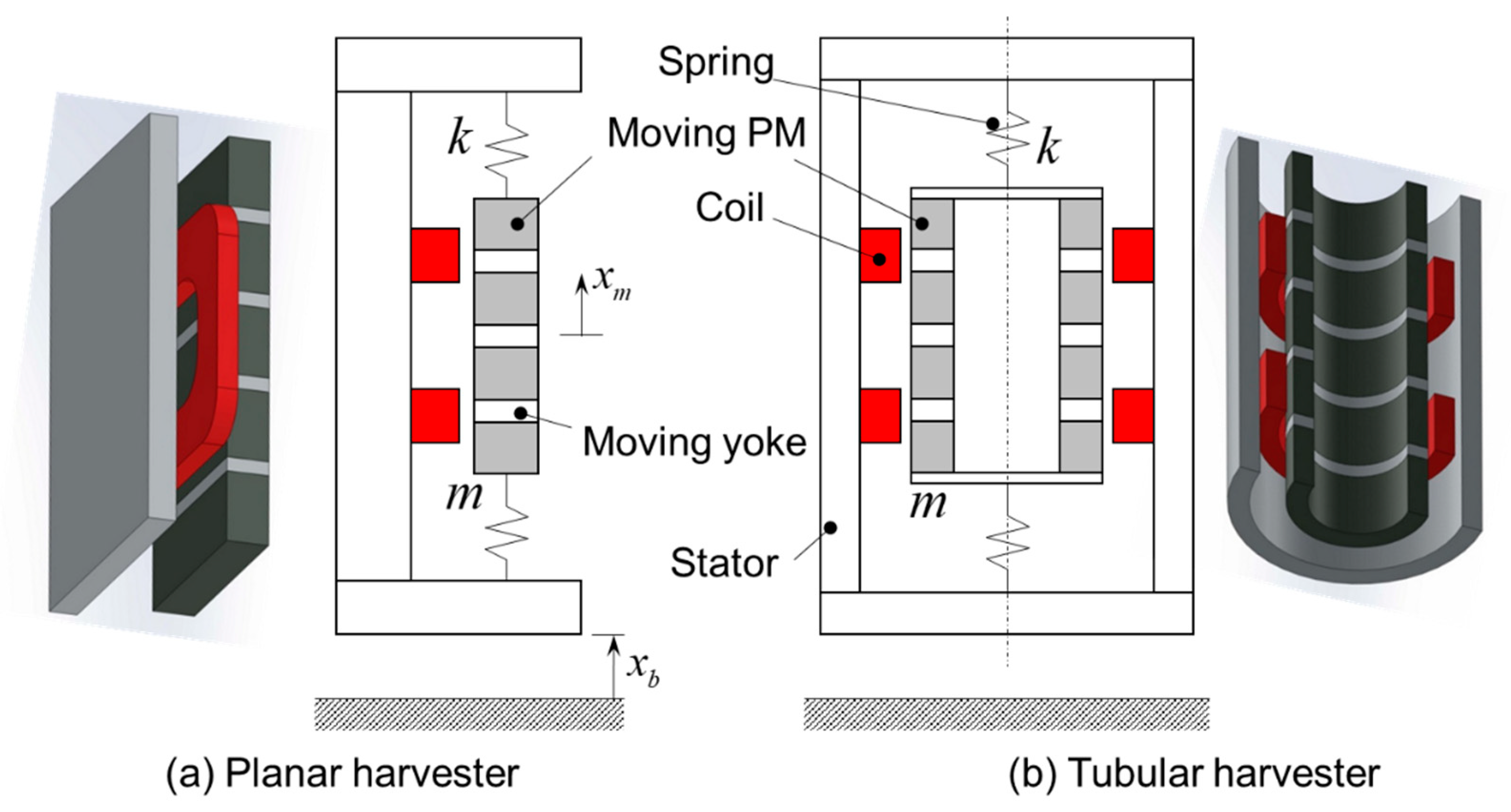Topology Selection and Parametric Design of Electromagnetic Vibration Energy Harvesters by Combining FEA-in-the-Loop and Analytical Approaches
Abstract
:1. Introduction
2. Electromagnetic Vibration Energy Harvester
2.1. Energy Harvesting Principle
2.2. Design Alternatives
3. Analysis Method and Optimization
3.1. Analysis Method
3.2. Validation of the Method
4. Results and Discussions
5. Conclusions
Author Contributions
Funding
Conflicts of Interest
References
- Priya, S.; Inman, D.J. (Eds.) Energy Harvesting Technologies; Springer: New York, NY, USA, 2009; p. 42. [Google Scholar]
- Mitcheson, P.D.; Yeatman, E.M.; Rao, G.K.; Holmes, A.S.; Green, T.C. Energy harvesting from human and machine motion for wireless electronic devices. Proc. IEEE 2008, 96, 1457–1486. [Google Scholar] [CrossRef] [Green Version]
- Qiu, J.; Liu, X.; Chen, H.; Xu, X.; Wen, Y.; Li, P. A low-frequency resonant electromagnetic vibration energy harvester employing the Halbach arrays for intelligent wireless sensor networks. IEEE Trans. Magn. 2015, 51, 1–4. [Google Scholar]
- Paulides, J.J.; Jansen, J.W.; Encica, L.; Lomonova, E.A.; Smit, M. Power from the people. IEEE Ind. Appl. Mag. 2011, 17, 20–26. [Google Scholar] [CrossRef]
- Seah, W.K.; Eu, Z.A.; Tan, H.P. Wireless sensor networks powered by ambient energy harvesting (WSN-HEAP)-Survey and challenges. In Proceedings of the IEEE International Conference on Wireless VITAE, Aalborg, Denmark, 17–20 May 2009; pp. 1–5. [Google Scholar]
- Kim, M.K.; Choun, Y.S.; Seo, J.M. Demonstration of the vibration control performance of coil spring-viscous damper systems by measuring the vibration of an emergency diesel generator. J. Vib. Control 2010, 16, 207–229. [Google Scholar] [CrossRef]
- Clarke, H.; Stainsby, J.; Carden, E.P. Operational modal analysis of resiliently mounted marine diesel generator/alternator. In Rotating Machinery, Structural Health Monitoring, Shock and Vibration; Springer: New York, NY, USA, 2011; Volume 5, pp. 237–244. [Google Scholar]
- Tse, K.H.K.; Chung, H.S. MPPT for Electromagnetic Energy Harvesters Having Non-Negligible Output Reactance Operating Under Slow-Varying Conditions. IEEE Trans. Power Electron. 2019. [Google Scholar] [CrossRef]
- Shousha, M.; Dinulovic, D.; Haug, M.; Petrovic, T.; Mahgoub, A. A power management system for electromagnetic energy harvesters in battery/batteryless applications. IEEE J. Emerg. Sel. Top. Power Electron. 2019. [Google Scholar] [CrossRef]
- Zhu, D.; Beeby, S.; Tudor, J.; Harris, N. Vibration energy harvesting using the Halbach array. Smart Mater. Struct. 2012, 21, 075020. [Google Scholar] [CrossRef]
- Zhu, D.; Beeby, S.; Tudor, J.; Harris, N. Increasing output power of electromagnetic vibration energy harvesters using improved Halbach arrays. Sens. Actuators A Phys. 2013, 203, 11–19. [Google Scholar] [CrossRef] [Green Version]
- Tang, X.; Lin, T.; Zuo, L. Design and optimization of a tubular linear electromagnetic vibration energy harvester. IEEE ASME Trans. Mechatron. 2014, 19, 615–622. [Google Scholar] [CrossRef]
- Lee, H.; Noh, M.D.; Park, Y.W. Optimal design of electromagnetic energy harvester using analytic equations. IEEE Trans. Magn. 2017, 53, 1–5. [Google Scholar] [CrossRef]
- Stephen, N.G. On energy harvesting from ambient vibration. J. Sound Vibr. 2006, 293, 409–425. [Google Scholar] [CrossRef] [Green Version]
- Rao, S.S. Mechanical Vibration, 5th ed.; Pearson: Singapore, 2011; pp. 154–196. [Google Scholar]
- Munaz, A.; Lee, B.C.; Chung, G.S. A study of an electromagnetic energy harvester using multi-pole magnet. Sens. Actuators A Phys. 2013, 201, 134–140. [Google Scholar] [CrossRef]
- Halim, M.A.; Cho, H.; Park, J.Y. Design and experiment of a human-limb driven, frequency up-converted electromagnetic energy harvester. Energy Conv. Manag. 2015, 106, 393–404. [Google Scholar] [CrossRef]
- Finite Element Method Magnetics (FEMM). Available online: http://www.femm.info (accessed on 30 December 2019).








| Parameter | Value | Unit |
|---|---|---|
| Mover mass () | 83 | g |
| Spring constant () | 361 | N/m |
| Excitation frequency () | rad/s | |
| Vibration amplitude () | 4 | mm |
| Gap between PM array and stator () | 5 | mm |
| Clearance between PM array and coil () | 2 | mm |
| Width of PM array () | 25 | mm |
| Thickness of PM array () | 5 | mm |
| Magnetization pattern | Halbach | |
| Coercivity of PM material | 883 | kA/m |
| Separation between coil legs () | 5 | mm |
| Number of coil turns () | 363 | |
| Coil resistance () | 8.3 |
| Excitation Frequency (Hz) | Predicted (V) | Measured (V) | Error (%) |
|---|---|---|---|
| 10.5 | 1.39 | 1.53 ± 0.039 | 9.3 |
| 10.6 | 1.40 | 1.34 ± 0.032 | 5.2 |
| 10.7 | 1.39 | 1.25 ± 0.027 | 9.5 |
| 11 | 1.27 | 1.31 ± 0.053 | 3.1 |
| 12 | 0.84 | 0.79 ± 0.029 | 6.8 |
| Structure | Planar | Tubular | ||
|---|---|---|---|---|
| Magnetization Pattern | Axial | Halbach | Axial | Halbach |
| Nonmagnetic stator | 31.1 | 44.2 | 50.8 | 60.4 |
| Magnetic stator | 51.4 | 77.8 | 79.1 | 94.7 |
| Increase due to magnetic stator | 65% | 76% | 56% | 57% |
© 2020 by the authors. Licensee MDPI, Basel, Switzerland. This article is an open access article distributed under the terms and conditions of the Creative Commons Attribution (CC BY) license (http://creativecommons.org/licenses/by/4.0/).
Share and Cite
Yoo, S.-y.; Park, Y.-W.; Noh, M. Topology Selection and Parametric Design of Electromagnetic Vibration Energy Harvesters by Combining FEA-in-the-Loop and Analytical Approaches. Energies 2020, 13, 627. https://doi.org/10.3390/en13030627
Yoo S-y, Park Y-W, Noh M. Topology Selection and Parametric Design of Electromagnetic Vibration Energy Harvesters by Combining FEA-in-the-Loop and Analytical Approaches. Energies. 2020; 13(3):627. https://doi.org/10.3390/en13030627
Chicago/Turabian StyleYoo, Seong-yeol, Young-Woo Park, and Myounggyu Noh. 2020. "Topology Selection and Parametric Design of Electromagnetic Vibration Energy Harvesters by Combining FEA-in-the-Loop and Analytical Approaches" Energies 13, no. 3: 627. https://doi.org/10.3390/en13030627






